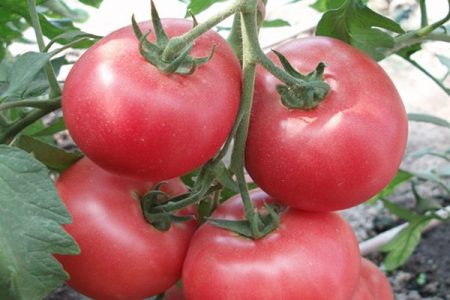
Ukrainian tomato variety "Bourgeois" appeared on sale in the early 2000s. During this time, tomatoes "won" the hearts of many gardeners. They are well grown both in the southern regions and in the middle lane of the country. Tomatoes "Bourgeois" can be planted in open ground, the variety is not afraid of cooling.
Tomatoes are used for various purposes: they can be salted, pickled, made from salads. Tomato pulp has a sweet taste and is juicy.
Content
Characterization and description of the variety
The determinant bush reaches a length of up to 1.5 meters. The stalk is powerful, but needs a garter. From one bush collect up to 4 kilograms of tomatoes. Plants are planted at the rate of 3-4 shrubs per 1 square meter of land.
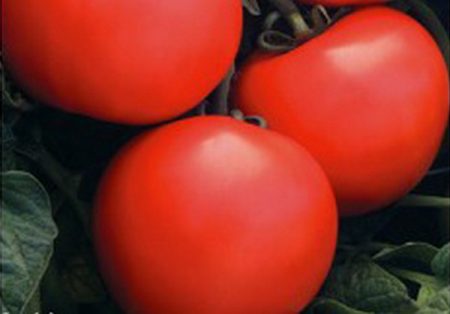
Tomatoes have an elastic red peel. It reliably protects tomatoes from damage and dents. Medium-sized fruits weigh about 200 grams, but sometimes larger representatives of the variety are also found.
Both methods of planting are acceptable for Bourgeois: open ground and greenhouse. The variety has good immune properties: plants do not suffer from fungal and other tomato diseases.
"Bourgeois" is a mid-season variety, the first tomatoes ripen 100-110 days after transplanting seedlings into the soil. With proper care and good weather conditions, earlier ripening is possible.
Growing Features
After the seeds are acquired, they begin to prepare for planting. To begin with, they are sorted out: small and ugly grains are removed. Bring a solution of potassium permanganate pink. The selected seeds are placed on the fabric, put in a bag and lowered into the solution for 5-10 minutes. Treated with potassium permanganate grains washed with water.
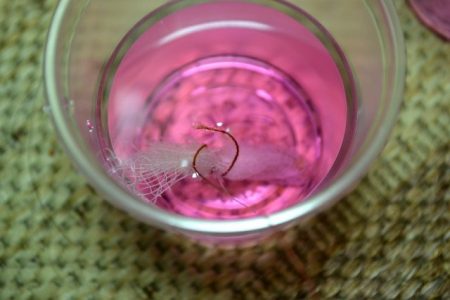
A wet cloth is placed on a pallet with a height of at least 3 centimeters. You can fold the cheesecloth into several layers. The fabric is soaked in a solution of potassium humate or any other fertilizer that stimulates plant growth. Spread the seeds on a cloth moistened with fertilizer, cover with a film and leave for several days at room temperature. After a couple of days, the seeds germinate and are ready for transplanting into the ground.
For growing seedlings, wooden crates or plastic containers are suitable. Boxes are filled with earth. Calcium is necessarily added to the ground - crushed chalk or eggshell. Tomatoes grow well in porous soil, so they add a little river dry sand and humus.
Seeds are lowered into the ground to a shallow depth and moisten the soil. During cultivation, seedlings are provided with regular watering. In addition to watering, boxes with tomatoes are set closer to the light source.
A month after planting, seedlings are dived. Pick-up is carried out at will and is not a mandatory item for execution. The procedure is carried out in order to slow down the growth and extension of seedlings. Dive plants with 4-6 sheets of moist earth into separate containers of larger diameter. It is not necessary to completely separate the earth from the roots. After a dive, the tomatoes are shed with diluted sodium humate.
To plant tomatoes in a greenhouse begin in early May. Tomatoes take root well in acidified soil with pH = 6-6.5.
Glasses are lowered into a bucket with dissolved mullein or chicken droppings.Wet soil with a plant is taken out of a glass and lowered into a dug hole. After transplantation, the soil is mulched with sawdust. Mulching protects the soil from waterlogging, sawdust instantly absorb excess water, and then dry. Moreover, air exchange improves, the roots are provided with a constant access of oxygen.
When the bush reaches a height of 35-40 centimeters, it is tied. In the greenhouse, the garter is carried out to the trellis. For outdoor cultivation, pegs 70-90 centimeters long are used. Garter reduces the formation of stepsons and allows the young plant to fully develop.
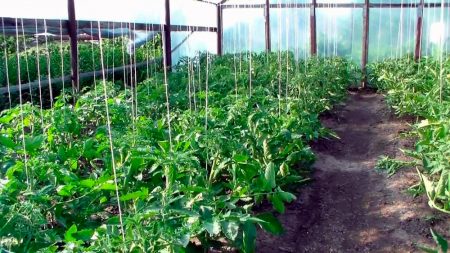
Water the tomatoes regularly. The frequency of watering depends on the outdoor temperature. With drought, water the tomatoes once every two days. If the weather is rainy, then once a week is enough.
For abundant growth, tomatoes are sprayed with infusions of onions, chicken droppings. Tinctures are prepared simply: 3 chopped onion heads or 200 grams of chicken droppings are poured with a bucket of water and insisted for 2 days. Then the mixture is filtered and the tomato stem and leaves are sprayed once every ten days. With regular spraying, the likelihood of getting sick decreases, and the protective properties increase.
Harvesting and storage
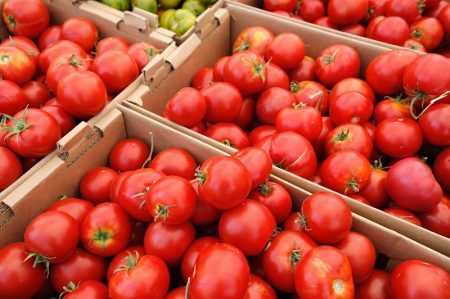
By the end of summer, tomatoes in the greenhouse begin to ripen. Only ripe fruits are harvested, the rest are left to ripen. Typically, most tomatoes ripen by mid-August. If tomatoes were planted in open ground, then they are plucked green. Then the ripened fruits are put in a warm, bright place and left there for a week. Tomatoes are turned upside down to keep the color uniform.
Store ripe red tomatoes in a cool place. If the tomato becomes soft to the touch, then it must be used immediately, otherwise it will deteriorate. Red tomatoes can be stored for up to one week. In addition to slicing into salads and making pickles, tomatoes can be frozen for the winter. They keep their shape perfectly and are not damaged at low temperatures. Thawed tomatoes are added to various dishes, they do not change their taste.
Advantages and disadvantages
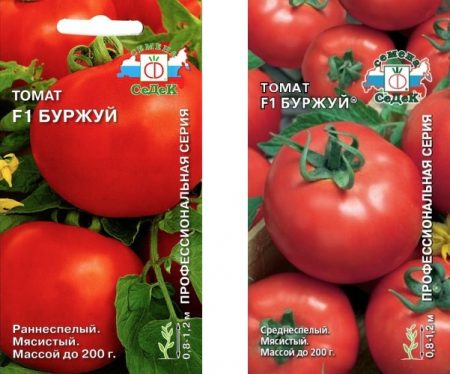
Advantages:
- beautiful shape and juicy sweet taste;
- resistance to cold, the ability to land on the street;
- good yield;
- immunity to vegetable diseases;
- universal application.
There were no shortcomings in the Bourgeois tomato variety.
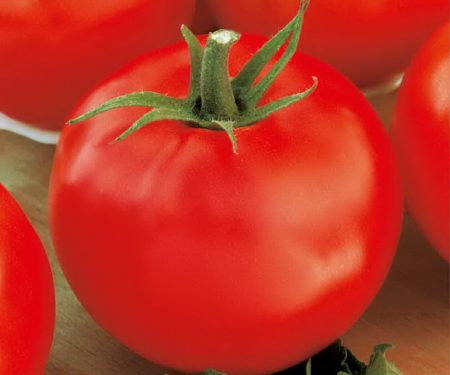
Reviews
Vitaliy from Novosibirsk says: “Tomatoes of the Bourgeois variety have a rich taste and pleasant aroma. They can be used for salting, cooking lecho, tomato juice. I have been growing this variety for two years in a row and I will be happy to continue it. ”
Albina adds: “I liked the variety very much because of its unpretentiousness in cultivation. Tomatoes planted in open ground. The result was good: 4-5 branches with tomatoes grew on one bush. I advise you to land. "




 Low-growing tomatoes, without pinching: 5 of the most delicious varieties
Low-growing tomatoes, without pinching: 5 of the most delicious varieties Why tomato seedlings grow poorly
Why tomato seedlings grow poorly We grow a tomato in a shell
We grow a tomato in a shell Growing tomatoes without watering according to the method of Kazarin
Growing tomatoes without watering according to the method of Kazarin